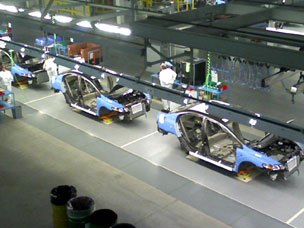Hecho En Los Estados Unidos

I’ve long argued that if Detroit were to be nationalized (and it was, not that I’m arguing it was a good idea) the US government should make Detroit make it worth the taxpayers’ while and return production from low wage countries, such as Mexico, to the United States. This would have two effects: more US citizens would be hired and the government’s trade deficit would be reduced. Hey, if you’re going to make a private enterprise a government arm, then make that government arm contribute something positive to the country. Much of Detroit’s portfolio is made in Mexico: the Ford Fusion, the (yet to be released) Ford Fiesta, The Ford F-Series, the Chevrolet Silverado/GMC Sierra, the Chevrolet Aveo/Pontiac G3 and the Chevrolet HHR to name but a few. This has long been a practice of Detroit and some transplants (e.g., VW with the Jetta and Beetle; Toyota with the Tacoma). Exploit low wage countries for maximum profits in higher wage countries. Well, Honda didn’t get the message.
Columbus Business First reports that Honda’s Greensburg, Indiana, plant is gearing up production of Honda Civic saloons for export to Mexico and 22 other Caribbean and Latin countries. “Manufacturing products for export broadens the experiences of our associates, contributes positively to America’s and Indiana’s international trade, and shows our commitment to the continued growth and evolution of our business in Indiana,” Rick Schostek, vice president for Honda Manufacturing of Indiana.
Now, considering Honda are one of the few car companies in this downturn to still make a profit, I’m guessing they’ve calculated this move very carefully to make sure they’ll turn a profit. Which goes to show you that you CAN make a car (and this is a small car, one of the least profitable segments there is, according to Detroit) in a high wage country and still turn a profit in a low wage country. Kind of reminds me of when Detroit said they couldn’t meet 1970’s emission laws in the United States without the use of a catalytic convertor; until Honda proved them wrong about that, too.

More by Cammy Corrigan
Latest Car Reviews
Read moreLatest Product Reviews
Read moreRecent Comments
- BrandX "I can charge using the 240V outlets, sure, but it’s slow."No it's not. That's what all home chargers use - 240V.
- Jalop1991 does the odometer represent itself in an analog fashion? Will the numbers roll slowly and stop wherever, or do they just blink to the next number like any old boring modern car?
- MaintenanceCosts E34 535i may be, for my money, the most desirable BMW ever built. (It's either it or the E34 M5.) Skeptical of these mods but they might be worth undoing.
- Arthur Dailey What a load of cow patties from fat cat politicians, swilling at the trough of their rich backers. Business is all for `free markets` when it benefits them. But are very quick to hold their hands out for government tax credits, tax breaks or government contracts. And business executives are unwilling to limit their power over their workers. Business executives are trained to `divide and conquer` by pitting workers against each other for raises or promotions. As for the fat cat politicians what about legislating a living wage, so workers don't have to worry about holding down multiple jobs or begging for raises? And what about actually criminally charging those who hire people who are not legally illegible to work? Remember that it is business interests who regularly lobby for greater immigration. If you are a good and fair employer, your workers will never feel the need to speak to a union. And if you are not a good employer, then hopefully 'you get the union that you deserve'.
- 28-Cars-Later Finally, something possibly maybe worth buying.































Comments
Join the conversation
Morea, You can read about Chrysler's own independent lean-burn system here: http://www.allpar.com/mopar/lean-burn.html "Lanny Knutson wrote in the Plymouth Bulletin (reprinted by permission): A new electronic spark advance module called Lean Burn was introduced by Chrysler [in 1976] on all its 400 and 440 engines. Six sensors monitored the engine RPM, manifold vacuum, water temperature, ambient temperature, intake air temperature and throttle position, sending the data to a small computer unit mounted on the air filter housing. A pioneering version of what is now under the hood of nearly every contemporary car, Lean Burn was designed to avoid the driveability problems usually arising from manually leaned carburetors. Although it gained approximately one mile per gallon, the primary purpose of the system was controlling emissions inside the engine. For a time, it permitted Chrysler to avoid use of expensive power-robbing catalytic converters. In 1977 Lean Burn was extended to the 360 engine. [It was later put onto the 318 and Slant Six before.]"
Thanks windswords!